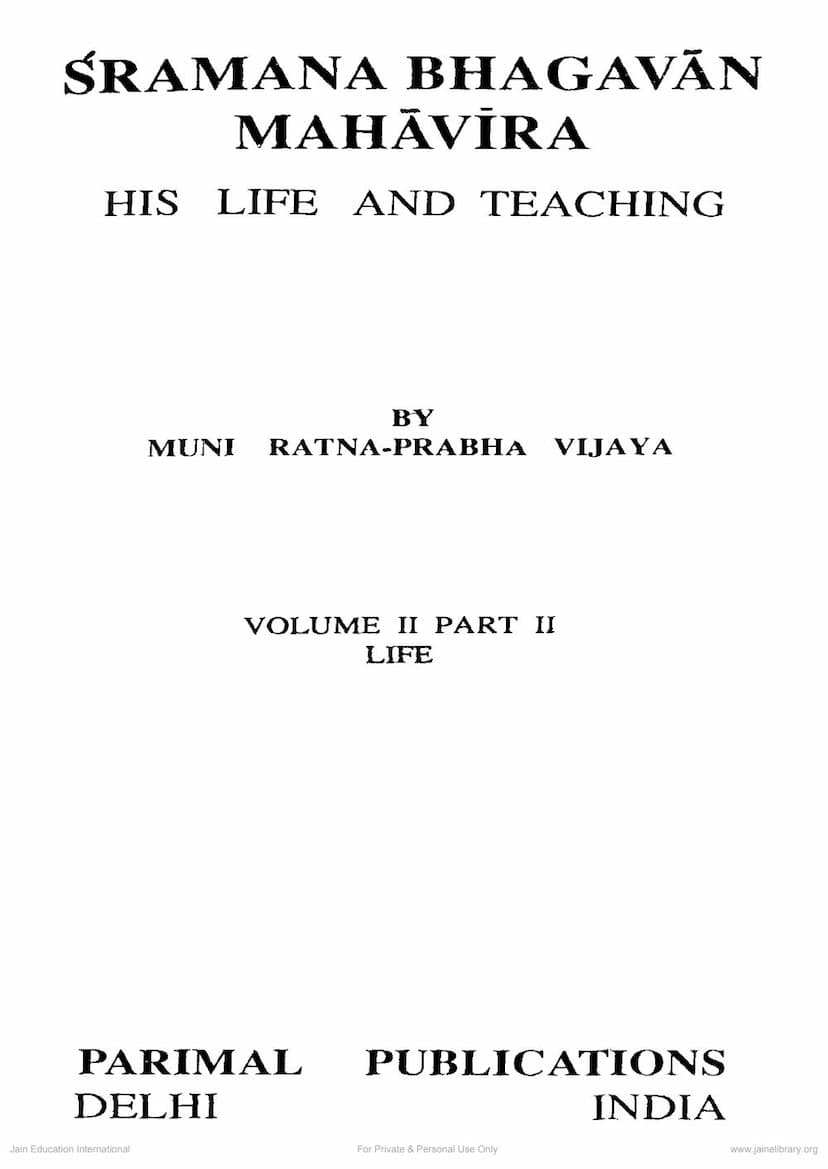Shraman Bhagvana Mahavira Part 2 Vibhag 2
Added to library: September 2, 2025

Summary
Here's a comprehensive summary of the provided Jain text, "Shraman Bhagavan Mahavira Part 2 Vibhag 2":
This extensive Jain text, "Shraman Bhagavan Mahavira Part 2 Vibhag 2," authored by Muni Ratna-Prabha Vijaya, details the life and teachings of Lord Mahavira, focusing on the period after he attained Kevala Jnana (omniscience). The book is organized into chapters covering key events and teachings from the first to the twenty-eighth year of his ascetic life and beyond.
Key Events and Teachings Covered:
- Attainment of Kevala Jnana: The text begins by describing Lord Mahavira's attainment of Kevala Jnana and Kevala Darśana at Jrimbhika-grama, detailing the precise location, time, and circumstances under the Sala tree. It highlights his omnisciscience and his ability to perceive the past, present, and future of all beings.
- First Samavasarana: The divine assembly (Samavasarana) prepared by gods for Lord Mahavira's first sermon is vividly described, including its elaborate decorations and the presence of gods, humans, and animals.
- Dharma-desana (Sermon): The book details Lord Mahavira's initial sermon, noting that although no one was immediately enlightened or took vows, his preaching was not futile. It also mentions the establishment of the Catur-vidha Sangha (four-fold monastic order: monks, nuns, laymen, and laywomen).
- The Eleven Ganadharas: A significant portion of the text is dedicated to the conversion and discourse with the eleven highly learned Brahmins who became Lord Mahavira's chief disciples (Ganadharas). Each chapter focuses on one Ganadhara, detailing their background, their doubts (e.g., about the existence of the soul, karma, the elements, the soul-body relationship, the next world, or liberation), and Lord Mahavira's refutation of their misconceptions based on Vedic interpretations and logical reasoning. The eleven Ganadharas discussed are:
- Indrabhuti Gautama
- Agnibhuti
- Vayubhuti
- Vyakta
- Sudharma
- Mandita
- Maurya-putra
- Akampita
- Acala-bhrata
- Metarya
- Prabhāsa
- The Great Vows (Maha-vratas): The text meticulously outlines the five great vows central to ascetic life in Jainism:
- Ahimsa (Non-violence)
- Satya (Truthfulness)
- Asteya (Non-stealing)
- Brahmacharya (Celibacy)
- Aparigraha (Non-possession) Each vow is explained with its clauses, detailing the specific actions to be avoided and the reasons for abstaining.
- Householder's Vows (Anu-vrata and Siksa-vrata): The book also details the twelve vows for householders, which are categorized into:
- Samyaktva (Right Belief)
- Five Anu-vratas (minor vows): Ahimsa, Satya, Asteya, Brahmacharya, Aparigraha (with less strict observance than the Maha-vratas).
- Three Guna-vratas (qualitative vows): Dig-virati (limitation of movement), Bhogopabhoga-parimana (limitation of consumption), and Anartha-danda-viramana (abstinence from sinful occupations).
- Four Siksa-vratas (disciplinary vows): Samayika (meditation), Desavakasika (limited renunciation), Pausadha (fasting on auspicious days), and Atithi-samvibhaga (offering food to ascetics).
- Key Disciples and Their Stories: The text narrates the stories of various significant lay disciples who took vows and renounced the world, including:
- Candana Sadhvi: Her Diksha and establishment as the chief of the nuns.
- Megha Kumara and Nandisena Kumara: Sons of King Srenika who took Diksha, with detailed accounts of their spiritual journey and overcoming worldly temptations.
- Salibhadra Setha and Dhanya Setha: The striking contrast between their previous worldly prosperity and their ultimate renunciation and severe austerities. The text includes dramatic narratives of their lives and the lamentations of Salibhadra's mother, Bhadra Sethani.
- Prasanna Chandra Rajarshi and Valkalaciri: The former's transformation from a king to an ascetic after realizing the futility of worldly power and the latter's story of ignorance and eventual enlightenment.
- Kunda Kolika and Suradéva Sravaka: Wealthy householders who took vows and were tested by deities.
- Saddala-putra: A potter who renounced his false Ajivika beliefs after a debate with Lord Mahavira.
- Mahasataka Sravaka: His story of piety, virtue, and the consequences of anger.
- Ardra Kumara: His spiritual journey, including the story of his previous life and his eventual enlightenment.
- Jayanti Sravika: Her steadfast devotion and her questions about the soul, karma, and salvation.
- Janali Muni: His deviation from Mahavira's teachings, his proclaiming himself omniscient, and his eventual downfall.
- Skandaka Katyāyana: His intellectual doubts and eventual enlightenment.
- Halla and Vihalla: Princes of Vaishali whose battle led to their renunciation.
- Arjuna Mali: His story of possession by a Yaksha and eventual liberation through Sudarsana Setha's influence and Mahavira's preaching.
- Royal Patronage and Interactions: The book details the interactions of Lord Mahavira with prominent kings of the era, particularly King Srenika of Magadha and King Prasanjit of Kosala. It describes King Srenika's conversion to Jainism, his political acumen, his family life, and the tragic circumstances surrounding his death at the hands of his son Ajatasatru (Kunika).
- Debates and Philosophical Discussions: The text records discussions Lord Mahavira had with various philosophers and ascetics of other sects, including Gośalaka Mankhali-putra, Buddhist monks, Sankhya mendicants, and Brahmana ascetics. These dialogues highlight the superiority of Jain philosophy, particularly its emphasis on non-violence, self-control, and the doctrine of karma.
- Concepts of Time and the Universe: The book delves into discussions about the nature of time, the universe (Loka and Aloka), the soul (Jiva), and the non-soul (Ajiva), explaining their eternality and interrelationships.
- Kala Pramana (Time Calculation): An extensive explanation of the Jain concepts of time measurement, from moments (Samaya) to Sagaropama, is provided, illustrating the vast scales of time in Jain cosmology.
- Strange Events and Miraculous Occurrences: Several stories highlight peculiar events and miraculous occurrences associated with disciples, demonstrating the power of austerities and devotion.
Overall Purpose:
"Shraman Bhagavan Mahavira Part 2 Vibhag 2" serves as a comprehensive narrative of a crucial period in Lord Mahavira's life, showcasing his profound spiritual influence, his methodical approach to establishing the Jain Tirth, his detailed explanation of Jain ethics and philosophy, and the profound impact his teachings had on individuals from all walks of life – from kings and merchants to ordinary citizens and even animals. The book emphasizes the importance of right faith, right knowledge, right conduct, and the adherence to vows for spiritual progress and ultimate liberation.